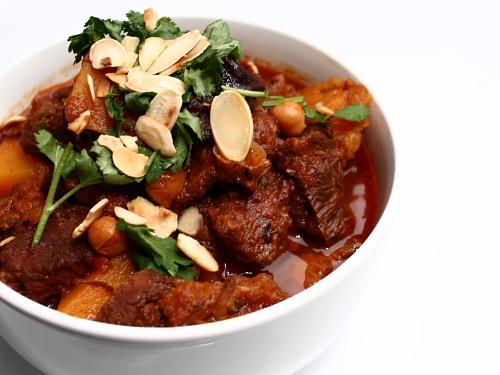Moroccan cuisine is rich with influences that betray the country’s history as a strategically important place, with distinct Arabic influences laid over more obvious North African traits. There’s also Moorish and European influence in there, too, pointing to Morocco’s closeness to Spain, and its position as a gateway to southern Europe.
The tagine is emblematic of the nation’s food.
It’s a versatile, one pot dish, cooked slowly and gently to give the spices time to deliver their punch and the meat time to melt and tenderise.
Tagines take time to cook, but are quick to prepare…short bursts of activity punctuate long periods of watching a slowly bubbling pot. The process is very rewarding, as you watch an unpromising pile of ingredients blend themselves together into a sublime dish.
This version uses beef. Any stewing cut will do, but shin is the tastiest and best suited to sturdy flavours and long cooking.
Chop 600g of shin beef up into bite sized pieces and add a spice rub made from a level tablespoon each of ras-el hanout, ground cumin, ground cinnamon, ground ginger and sweet paprika, seasoned with salt and black pepper. Toss the beef around to make sure that the spices completely cover it.
Cover the meat and leave it in the fridge for a few hours, overnight if possible.
Ras-el hanout is a mysterious ingredient. It’s best likened to a garam massala, although in taste and composition it’s completely different. No two ras-el hanouts are the same, but they’re fundamentally a mix of cardamon, cloves, cinnamon, cayenne, cumin, coriander, nutmeg and the like. Some mixes have over a hundred ingredients.
My packet was marked as one of Delia Smith’s ‘cheat’ ingredients, but please don’t let that put you off.
Putting the dish together is very easy. Fry the meat for five minutes or so in a medium hot pan with a big glug of oil until it starts to brown and singe at the edges.
Add a finely chopped onion and the chopped stalks from a small bunch of coriander to the pan and continue to stir and cook for another five minutes before adding a drained can of chickpeas and a can of chopped tomatoes, along with 400ml of vegetable stock or water. Bring it all to the boil, cover and reduce the heat to a gentle bubble. Leave for an hour and a half.
Next, add a smallish squash – a butternut squash will be fine – peeled, the flesh chopped into big chunks. Also add 100g of prunes, each one cut in half.
Top the pan up with another 400ml of stock or water, cover and leave for another hour and a half.
Keep an eye on the pot and top up with a little more water if it starts to look too dry. If, after the cooking time is up, the sauce is too thin, turn the heat up and reduce, uncovered, for a few minutes.
Check the seasoning and test the beef to see that it’s tender to the point of disintegrating.
Serve with some chopped coriander leaves and a few sliced, toasted almonds over the top, some flatbreads or plain couscous on the side.
This recipe is from Jamie Oliver’s excellent Jamie Does…

